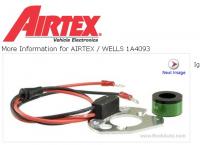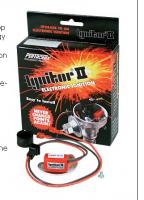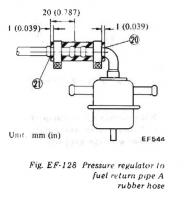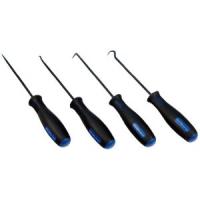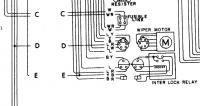Everything posted by Zed Head
-
ZFuel
Seems like it might be easiest, though not as fun, to just install it, drive it, watch the AFR's, and use the GUI "wheel" to change the slope and the base pulse width to set the "y". Just sayin', the time spent on figuring out stock AFM flow-voltage curves might be moot. That's the point of adjustability, right? So we can tune to our set of old used parts. The AFM's are also complicated by the shape of the air passage. It's not a vane in a straight tube, it's a vane in a contoured passage. Nissan must have spent a lot of trial and error time getting things just right.
-
Drum and Toyota 4x4 front brake questions.
These guys seem to have all of the things that you're looking for, except the drum shoes. To each his own, have fun. Click around the Products section. Silverminemotors.com Edit - should say that Eurodat gave good advice. But sometimes it's just fun to modify anyway.
-
High RPM problems.
Thanks for getting back. So there are either two sets of instructions floating around for the 1761 Ignitor, one paper and one internet, and they use different specs. for the coil recommendations. Good to know. Have to say that although the Pertronix products were probably innovative when introduced, they don't seem to have done much with them but ride the brand name in the last few years or more. Looks like they're even sticking the brand name on GM HEI modules, and generic aftermarket electronic ignition parts. No offense, just a commentary on how popular products change over time. I'm sure that they still work great once you get them set up right. Performance Ignition Modules Compare the RockAuto electronic ignition to the Ignitor II. Kinda interesting... Edit - actually, that looks like the Ignitor I, I guess. And, contrary to most brand names, the name brand is cheaper. Over $160 for the Airtex. More weird. I don't get it.
-
High RPM problems.
Great that you're getting closer. I was just trying to give some insight on basic electrical principles. Can you give the part number of your Pertronix part? I'm always interested in figuring out which web sites have good info and which don't and how companies' various products work. I'm surprised that your instructions are different from the Summit Racing instructions, which appear to be generic to all Pertronix Ignitors. Maybe you have a II or III Ignitor? I opened up the Summit instructions for 1761 referred to in madkaw's #15 and it says 3 - 4.5 ohms for 1 - 6 cylinders, on a 12 volt system. Just a little unclear on the details, you seem to have a different Ignitor.
-
High RPM problems.
That's for the coil. But the Pertronix Ignitor seems to like about 3 ohms total, coil and resistor, I believe. I know that there have been many discussions about the topic. Here's a link to the recommended coil , it comes in 1.5 or 3 ohm flavor. Oddly, there are no specs or instructions for the Ignitor on their web site, so unless the paper instructions give advice, it's trial and error. Edit - I did find instructions on Summit Racing's site though. Might not be the exact kit but the general specs. should be the same. Calls for 3 - 4.5 ohms on the primary circuit. Edit 2 - if you do have a low resistance coil you can just add a resistor to get in the right range for the module. Or buy a coil with those specs. Edit 3 - Note also in the Summit instructions the recommendation to check the Pertronix sticker for signs of over-heating. Obviously a fairly common problem. http://www.summitracing.com/parts/pnx-1181/media/instructions 40,000 Volt Canister Coils Ignitor
-
High RPM problems.
Great that you took the time to find a scope and use it, but I think that you were looking at the wrong things. Voltage is not "demanded", it is produced, or available. Current could be considered to be a demand item, it is a function of resistance and voltage. The 50,000 volts that you measured is about normal for some coils, but could be a sign of too much current through the coil and module (the Ignitor), which could be caused by a bad ignition module or low resistance on the coil's primary circuit. As madkaw suggests, have you measured resistance on the primary circuit? Maybe you just need a resistor in the line. If you get a similar coil you might just end up with the same problem.
-
High RPM problems.
Sounds like you're going to buy a new coil anyway so it doesn't really matter which you do first. A coil is probably cheaper than a new Ignitor. Good luck.
-
High RPM problems.
Isn't one advantage of the Pertronix, over other electronic ignitions, that you can pop the points back in easily? Might be a quick way to test the Ignitor.
-
Georgia on my mind
Don't you want to know about moving to Georgia? It's not Arizona. They got skeeters and snakes and tings that make weird noise in the night.
- Help with Throttle Position Sensor 78 280 Z
-
Help with Throttle Position Sensor 78 280 Z
Pictures look great. Well-sized. Looks like someone installed a 75-77 FPR on your 78 fuel rail. It should work fine, but that's why it's not attached properly and has the blocked off port. Not the safest set-up either since the only thing holding the FPR on is the hose clamps on the inlet and outlet ports (unless there's a bolt that I can't see in the picture). If the clamps loosen it could pop right off and the engine would get dowsed with gasoline. Check those clamps and see if you can get a bolt in to the bracket. The part of your situation that seems most important is that the engine died and you had to have the car towed. If it was a simple tuning problem, you should be able to drive around with low power all day. Does the engine start now? If so, it could be a heat-related problem, if not, maybe something broke unrelated to the low power problem.
-
Checking Timing Chain Stretch
You should be able to just put the new sprocket back on using the same dowel hole - 1, 2 or 3. Assuming that the flaw with the old sprocket is just the fact that they didn't cut the notch in it. Once it's on, you can determine if cam timing is retarded or not. And, if the old sprocket isn't worn out, the only reason to install the new sprocket is to check cam timing. So, you could also get a used one and stick it up next the old one, aligning teeth and 1-2-3 holes, and check notch alignment. Or, if you're good with measuring tools you could even transfer the notch location to the old sprocket and just leave it on. Just offering a new view. Nissan stopped referring to chain stretch in the later ZX FSM's. I wonder if it really has that much effect, considering all of the other things that wear. The funny thing about it is that it moves the power peak to higher RPM (as I understand things). Which is what people who modify usually want to do. My thought has been that one cheap way to make a higher revving engine is to put a used chain on.
-
Turn signal flashing time
How fast are yours now? Maybe they're abnormally slow and a stock replacement would do the job. Need numbers.
- just bought my self a 73 Z having a few issues
-
just bought my self a 73 Z having a few issues
I've found that a hook-shaped pick does the job for the door handle retainer. It's on the splined shaft, you can see it if you try. You can get something like these almost anywhere. The screws for the door handle are deep in the holes on the bottom of the arm rest, plus one under the chrome piece at the top front, which pops off. Big head, about a #3 screwdriver.
-
This guy asks 14.5 k for 24 Valve Goerz Paeco DOHC Head
He'd have to throw in the other head (looks like an N42 with a later cam, internally oiled) to to make it worth considering. And the little stand.
-
Checking Timing Chain Stretch
Found a link on ratsun that suggests some sprockets don't have the mark. Still wouldn't makes sense to have the 1, 2 and 3 numbers, but no mark. Post #12 - does this cam timing look correct? - Engine - Ratsun Forums
-
Checking Timing Chain Stretch
Something seems weird then. One of those three holes should be up near the top so that you can look through it. I think that each one has a notch. And one of those three holes that was under the bolt washer should have the can shaft dowel in it, you can check that. Maybe someone in the past broke the dowel and eyeballed the camshaft sprocket in to place, locking it down with clamping pressure. One of the guys on here who's done more engine work should have an idea. Doesn't look right (to me) for the settings you described.
-
Checking Timing Chain Stretch
Is that picture from when you had everything set to zero? No sprocket bolt, and the holes in the sprocket aren't at the top where the groove is. You might be on the exhaust stroke for piston position. The timing mark actually passes zero twice for each chain sprocket revolution. Check that the cam lobes are both up, not contacting the rocker arms. The sprocket has the 1, 2 and 3 adjustment holes so it should have the notch also, to show the need for adjustment. The first is not much good without the second.
-
Help with Throttle Position Sensor 78 280 Z
What does it do when it lacks power? Does it cough and buck and backfire, or just "bog" when you give it gas, or blubber and choke like it's flooding? With 45 psi you might have been running rich with fouled plugs, and finally fouled too many on the way for the engine to run. Coughing and back-firing is typical of lean, fouling plugs can happen if it's rich. "Bogging" could be timing. I would pull the plugs to see what the few miles of driving did to them (keep them in order 1 - 6 in case you have cylinder-specific problems), test all of the EFI components from the ECU connector that you can figure out from the FSM so you'll know from the start what the ECU sees, and check the timing (pretty common to have someone turn the distributor to see what happens and get the timing either way retarded or way advanced). Didn't realize it was that bad. Good luck.
-
SS Voltage Regulator
I think that the fact that you knocked the cap off with your hand shows that it wasn't properly locked down anyway. So, probably lucky in the long run. You could have spent hours trying to find the source of a random miss, caused by the cap moving around. All of the Z's seem to be on the edge for amps at idle. An extra 100 engine RPM can make a big difference. I've also found that the factory made alternators seem to put out more idle current than the typical aftermarket alternator. Personally, I will always run old Nissan alternators until I run out, over "new" refurbished parts store alternators, but I have several wrecking yards in the area to choose from. And there's no guarantee that more peak output will produce more idle output, the output curve slopes seem to change between various alternator brands. It's a dilemma.
-
Do spindle pins need to come out for springs/insulators?
To add a little to what Jon M. said - on the 280Z you'll need to loosen the control arm inner mounts a little bit to get the top of the strut out from under the fenderwell (I think JM has a 240Z). The 280Z strut is taller than the 240Z so it needs to drop down farther to clear (Blue's three 240Z links may not apply directly). But it is doable, I swapped my rear springs a while ago doing it that way. I think that I might have left the brake lines attached too, but it's risky. If things slip you can damage them. If I recall, I also had to disconnect the halfshafts because they wouldn't drop down far enough otherwise. The thing about these time-savers though, is that after your first try you'll probably get done and say "it would have been faster if I had just taken it out completely". You'll forget something or something will slip or you'll get in a bind and spend time thinking instead of doing. After you've done one, the short-cuts make more sense.
-
280Z Full Restore in 5 months, hopefully.
Whose Goat? rcb is right. Topsy-turvy.
-
Starter question
You could reconnect everything to see if the switch is bad. If it still does it, ordering a switch might be a good idea. If not, you've ordered an extra switch. I copied the relay picture. I didn't follow all the traces but yellow/black is power to the starter solenoid (it's where "E" goes). Black/yellow is the other side of the relay, which I think is what needs power. SteveJ probably knows but maybe you went yellow/black, when you should have went black/yellow, and connected switched power to the solenoid.
-
Starter question
I'm going to guess that you jumped the wrong wires. Just because everything worked fine before. On the 76 cars, the power to the starter solenoid and the power to the ignition system are all on completely separate circuits, initiated at the ignition switch. Odds are you've jumped switched power to the starter solenoid wire The wiring diagram for the 260Z is harder to look at but here's a link if you want to dig in - http://www.atlanticz.ca/zclub/techtips/wiringdiagrams/74_260z_manual_wire.gif




